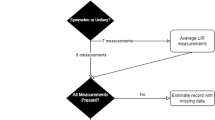Abstract
Gathering reliable and up-to-date full datasets of ISO-compliant anthropometric measures is time consuming and expensive. To use synergetic effects an explorative method was tested to use the environment of an existing population-based epidemiological study and extend the study design with additional three-dimensional body surface scans. Besides the standard algorithm based measure extraction, additional 34 ISO 7250-1 measures were extracted by manually identifying 44 anatomical landmarks on the 3D images. High priority was given to quality and reliability of the data. Therefore, standard operating procedures (SOPs) as well as a stringent quality assurance procedure were defined. In addition, three manually taken measures (height, waist-and hip-circumference) were compared to the extracted body scan data. The results of the manual reading process showed ambiguous results: some ISO measures showed a good intra- and interobserver reliability whereas others were difficult to identify on the scan images.
D. Bonin and D. Radke—Equal contribution.
Access this chapter
Tax calculation will be finalised at checkout
Purchases are for personal use only
Similar content being viewed by others
References
Wischniewski S, Bonin D, Grötsch A (2015) Virtual anthropometry—synthesis and visualisation of virtual anthropometric populations for product and manufacturing engineering. In: The Proceedings of the 19th Triennial Congress of the International Ergonomics Association—Melbourne, 9–14 Aug 2015
Wischniewski S, Grötsch A, Bonin D, Parkinson M (2017) Synthesis and validation of a virtual anthropometric user population of German civilians based on an up-to-date representative dataset. May ed. BAuA: Focus. BAuA, Dortmund
John U, Hensel E, Lüdemann J, Piek M, Sauer S, Adam C, Born G, Alte D, Greiser E, Haertel U (2001) Study of Health in Pomerania (SHIP): a health examination survey in an east German region: objectives and design. Sozial-und Präventivmedizin 46(3):186–194
International Organization for Standardization, ISO 7250:2010: Basic human body measurements for technological design
Kouchi M, Mochimaru M, Bradtmiller B, Daanen H, Li P, Nacher B, Nam Y (2012) A protocol for evaluating the accuracy of 3D body scanners. Work 41(Supplement 1):4010–4017
International Organization for Standardization, ISO 20685, 3-D scanning methodologies for internationally compatible anthropometric databases
International Organization for Standardization, ISO 15535, General requirements for establishing anthropometric databases
Martin Bland J, Altman D (1986) Statistical methods for assessing agreement between two methods of clinical measurement. Lancet 327(8476):307–310
R Core Team (2017) R: a language and environment for statistical computing. R Foundation for Statistical Computing, Vienna
Viera AJ, Garrett JM (2005) Understanding interobserver agreement: the kappa statistic. Fam Med 37(5):360–363
Feinstein AR, Cicchetti DV (1990) High agreement but low kappa: I. The problems of two paradoxes. J Clin Epidemiol 43(6):543–549
Cicchetti DV, Feinstein AR (1990) High agreement but low kappa: II. Resolving the paradoxes. J Clin Epidemiol 43(6):551–558
Kouchi M, Mochimaru M (2011) Errors in landmarking and the evaluation of the accuracy of traditional and 3D anthropometry. Appl Ergon 42(3):518–527
Han H, Nam Y, Choi K (2010) Comparative analysis of 3D body scan measurements and manual measurements of size Korea adult females. Int J Ind Ergon 40(5):530–540
Acknowledgement
We thank all SHIP participants, examiners, and readers. The Study of Health in Pomerania is part of the Community Medicine Research Network of the University Medicine Greifswald, which was supported by the German Federal State Mecklenburg-West Pomerania. The extension to the body scan examination and reading was funded by the Federal Institute for Occupational Safety and Health (BAuA), Germany.
Author information
Authors and Affiliations
Corresponding author
Editor information
Editors and Affiliations
Rights and permissions
Copyright information
© 2019 Springer Nature Switzerland AG
About this paper
Cite this paper
Bonin, D., Radke, D., Wischniewski, S. (2019). Gathering 3D Body Surface Scans and Anthropometric Data as Part of an Epidemiological Health Study – Method and Results. In: Bagnara, S., Tartaglia, R., Albolino, S., Alexander, T., Fujita, Y. (eds) Proceedings of the 20th Congress of the International Ergonomics Association (IEA 2018). IEA 2018. Advances in Intelligent Systems and Computing, vol 822. Springer, Cham. https://doi.org/10.1007/978-3-319-96077-7_14
Download citation
DOI: https://doi.org/10.1007/978-3-319-96077-7_14
Published:
Publisher Name: Springer, Cham
Print ISBN: 978-3-319-96076-0
Online ISBN: 978-3-319-96077-7
eBook Packages: Intelligent Technologies and RoboticsIntelligent Technologies and Robotics (R0)




